“In the absence of any empirical evidence to the contrary, the assumption had to be that females would be capable of performing all the diversified duties in the Force equal to males.” – RCMP Commissioner Maurice Jean Nadon, 1974
I was so impressed with the above noted quote in the context of the era it was voiced, I had it placed on the back of my book: The Red Wall; a Woman in the RCMP. It wasn’t until I was researching a chapter for a co-authored book on women in policing internationally that I realized-I gave the Royal Canadian Mounted Police much, too much credit for being a catalyst for gender equality in Canada. The Ontario Provincial Police deserved equal and perhaps more credit for that watershed moment in policing history and for some of the leadership milestones, which followed.
To be fair, neither of Canada’s two largest policing forces would have forged unchartered gender grounds at the time, without being mandated by government to do so; and to be really fair, government would not have mandated it, if women had not pressured them to act.
In the mid-nineteen sixties thirty-two women’s groups coordinated their efforts to pressure the Canadian government into improving gender equality. The Canadian government resisted the onslaught of letters and rallies but finally buckled when a march on parliament by two million women was threatened. The Royal Commission on the Status of women was created in 1967 to defuse the issue.
As Gordon Donaldson, a Canadian television anchor of the time, put it so cynically, “Royal Commissions are the traditional sidestep of Canadian leaders…Nothing like putting a hot topic in a cold committee room to cool things off”.
It was the first time a Canadian Royal Commission would be chaired by a woman. It was also the first time a Royal Commission would set out a blueprint to transform Canadian society and policing.
The Royal Commission explored the issue through exhaustive national interviews of women from east to west and north to south. The process took nearly three years; but in the end, the Royal Commission concluded that the myth of gender equality was not a reality for women in Canada.
Heart-breaking stories of rampant domestic abuse, girls as young as thirteen being forced into marriage because of pregnancy, pay discrimination, systemic government gender discrimination, academic double-standards and quotas at universities, which limited women’s educational and professional opportunities, overt gender injustices in the Indian Act, systemic poverty and much more shocked and outraged the female members of the Royal Commission. It is interesting to note that none of the women on the commission were considered feminist prior to the commission. Indeed, if they were, they would probably not have been selected by the government to serve on the commission.
In 1970, the five female members of the 1967 Royal Commission on the Status of Women tabled their report outlining 167 recommendations to parliament. Donald Gordon, the only man on the committee, had resigned early and was replaced by John Humphrey, who distanced himself from the report by tabling his own report more in line with the gender status- quo for society for the time.
The report tabled by the five women became the catalyst for changes to systemic gender-based discrimination in Canada. The fifty-fourth recommendations in the report directed the Royal Canadian Mounted Police to open its ranks to women.
Historically the RCMP had employed a very small number of females in specialized functions for nearly a century, as matrons, a gold assayer, as a civilian forensic specialist and in the mid 1960’s they were used on surveillance ; but the RCMP had never accepted women into their ranks, not even as special constables. The exclusion of women has Mounties was accepted as common sense, not discrimination at the time.
Police officers throughout most of the world and throughout history had always been large, tough men. That had led to the basic premise that being large, and male, was a necessary requirement for being a regular police officer. That assumption had historically limited women to supporting roles in policing.
For over one hundred years, various Canadian city police departments had employed women, first as matronsthen later as bylaw enforcement officers (meter maids) and in other limited supporting roles. In 1912, Vancouver City Police became one of the first Canadian police departments to grant police officer status to women when they hired Laurency Harris and Minnie Miller; but like every other police department in the decades which followed, their duties were restricted: they were not armed; they did not get uniforms for decades; and when they did, it was not the same uniform.
Retired Sgt. Raoul Carriere, the son of the Deputy Commissioner Rene Raoul Carriere (One of only two Deputy Commissioners to hold that rank in 1972) provided some first hand in-sight into how soon after the 1970 recommendation to parliament the RCMP executive were seriously contemplating and warming to the concept of women as Mounties.
“I was still a Constable, back home visiting, when my dad mentioned the RCMP was bringing women into the force. I said “hold on I would rather have the biggest meanest guy with me in a fight.” “
Raoul went on to say
“He (his father, Deputy Commissioner Carrier) countered, “The studies found you are much less likely to get into the fight if women are there. They will help keep the men out of trouble. ” At the time I couldn’t believe a Mountie, as tough and old school as my father, was saying that. It made me think and later I came to agree with him.”
The above noted conversation happened prior to the late Rene Carriere’s retirement in 1972, suggesting the RCMP’s executive may have accepted the concept of female Mounties in principle, but seemed in no particular hurry to translate the principle into a reality for several years. It wasn’t until the late summer of 1973 that the RCMP struck a task force on the topic.
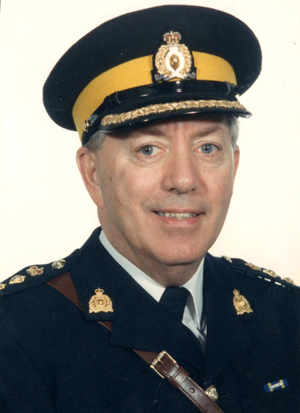
Photograph of RCMP C/Supt. Ed Wilson (Source of photo – RCMP Historical Collections Unit – “Depot” Division)
Retired Chief Superintendent Ed Wilson was the Inspector in charge of the a RCMP task force, which visited police departments in Toronto, Vancouver, Chicago and Michigan State, hoping to find a working model for operational female police officers. Unfortunately, the members of the task force found most police departments that had employed female police officers for decades had not implemented strategies to fully bring them into the main stream of all police functions and rank.
Female police officers in those departments were rarely, if ever, afforded the same powers, status, training, uniform and equipment as the men. On paper they may have been police officers, but in reality they were contained by glass ceilings and organizational barriers, which denied them the ability to move both laterally and vertically through the organization. The task force also came away with a preview of the police culture the first females would most likely face.
Ed Wilson recalled there was an incredible difference in attitudes concerning female police officers, sometimes between the frontline male officers (including junior NCOs) and the senior executive often within a single police department, and sometimes between police forces. Ed recalled:
“Many front line officers didn’t like them at all, while most of the executive were vocally supportive. Even some of the opinions of the executive of police departments could vary wildly. We visited Chicago and Michigan State police and found the executive at the top of one of the departments were very positive, but the other department was very negative on the issue of female police officers.”
If Ed Wilson’s impressions were the prevalent view concerning female police officers, it seemed predictable the working situation for the women had the potential to be quite unpredictable and dysfunctional, particularly since the majority of lower ranked male officers were openly negative about female police officers while the police executive officers publicly didn’t share that view. Since female police officers were at the low end of the rank structure at the time, it is reasonable to assume their work environment presented additional challenges male police officers did not face. Unfortunately the task force did not interview any female police officers for their thoughts and insights.
Ironically, one of the recurring sources of friction male officers voiced about female police officers centered on women being paid the same as constables but not being expected to perform all of the duties of constables. Had the task force interviewed female police officers they would have learned female police officers had long been complaining about not being allowed to perform the same duties as their male counterparts as well.
The executive police officers who professed to think so highly of female police officers could have changed the discriminatory policy restricting the role of female police officers in the majority of police departments in the kind of proactive organizational leadership which would have helped to promote a better and healthier workplace environment for both sexes. Unfortunately, most police departments didn’t change their policies until they were mandated to do so.
Ed Wilson recalled one high ranking Vancouver Police executive, not the chief, who very vocal and openly negative, an opinion which contrasted sharply with a junior non-commissioned Vancouver officer who thought so highly of the female police officer he had, he told Ed Wilson; “I wish I had more of them.”
Ed also recollected visiting Halifax Police Department during the task force time and found much the same reaction;
“It depended to whom I talked to whether they accepted females or not.” Ed Wilson
“In my twenty plus years of experience I rarely found universal acceptance as a female police officer. I quickly learned, working for a leader with a positive attitude far more critical to the work environment than being universally liked by my own rank, and later being universally liked by those I supervised. The tone was always set at the top as far as I could determine. The few toxic work situations I found myself in were always the result of hostile, weak or absent leadership which either promoted or fostered a toxic work environment.” Jane Hall, the author’s opinion.
While leading the RCMP task force Ed Wilson had a meeting with a member of the Ontario Provincial Police (OPP) who had been part of the OPP study on accepting women into the OPP ranks.
“I also spoke with a Sargent or Staff Sargent who participated with the OPP study and had a short meeting with him (I think) in Aylmer. He apprised me of much of the information we included in our study and they in their study.” Ed Wilson
Like the RCMP, the OPP had not allowed female members to be employed as police officers prior to 1974. In 1974 the RCMP’s task force report to the Police Sector Council and Commissioner Nadon recommended the RCMP proceed with the Royal Commission directive to employ women as regular police officers.
Wilson recalled the unanimous support of the executive officers in the RCMP to the recommendations of the task force’s report, though he did concede there may have been a bit skepticism which remained unspoken.
In the spring of 1974, the RCMP appeared to rapidly change gears, leaving one to wonder if the change in pace was solely due to the new progressive Commissioner (Nadon) or if there was some other factor or organization culture at play.
Nadon’s statement quoted at the beginning of the chapter is strikingly similar to one in an Ontario Provincial Police’s report to the Ontario government; an earlier report which goes much further on the suitability and potential of female police officers.
The task force on Policing in Ontario was established in 1972 by the Attorney General of Ontario to review police administration, organization and efficiency. It tabled its report in February of 1974. Excerpts from page thirty five of that report are as follows:
“We feel it essential that women find a larger role within Ontario police forces. Our view is more than an echo of the egalitarian sentiments of the day. There is no evidence to suggest that women are incapable of performing the police role in virtually all its aspects. Indeed, there is considerable evidence to suggest that women are more effective than men in family-crisis situations or incidents involving violence. Yet with few exceptions, policewomen in Ontario are relegated to juvenile or matron duties.
“Policing in Ontario has been a male preserve. We can imagine nothing which would more symbolize our intent to make police forces representative of, and sensitive to, the communities they serve than a major increase in the number of policewomen in Ontario.”
“We therefore recommend that:
“Rule 4.6 Ontario police forces be encouraged by the Ministry of the Solicitor General and the Ontario Police commission to recruit female police officers for specialized and general duties, with the opportunity for advancement equal to their male counterparts, and that there be no discrimination according to sex in recruiting or promotional opportunities.” ”
When I examine the evidence and time line, it is clear that the Ontario Provincial Police was quicker to accept, and act on the concept of women as regular police officers than the RMCP.
Knowing the competitive nature of police cultures, I suspect the RCMP’s kick start to the implementing the Royal Commission’s directive was influenced by the Ontario Provincial Police’s swifter compliance (two years compared to four) with a similar mandate from the Ontario Provincial Government.
Training differences between the RCMP and the OPP and their effect on the first female members
In May of 1974, the OPP were already swearing in their first female recruits, when the RCMP was making its announcement that it intended to do the same. Whatever the reason for the accelerated time frames, it was welcome news to the women of Canada who had been waiting for the opportunity to become police officers and to be a part of this new reality, women like Bev Busson.
Bev, a newly graduated teacher, was driving to her summer job when she heard an announcement on the radio that the RCMP had begun accepting women. She immediately drove to the nearest detachment in Dartmouth, Nova Scotia, and applied. She recalled,
“The members at the office that morning were just recovering from the “breaking news…”
It appears it wasn’t just the detachment which was a little unprepared for the acceptance of female Mounties. Bev recalled;
“There was a quick deadline…May to September from the decision to the arrival of the first female troop in Regina….I remember that during the application process, there was no medical form for females, so they had to improvise. I remember the doctor smiling and asking me to cough…”
Rightly or wrongly, the RCMP has captured the world’s imagination and admiration, and embodies the Canadian national identity. For those reasons, when the RCMP decided to open its ranks to women, the county and the world were watching. Time Magazine came to Depot (the national training center for the RCMP) and featured a graduating female troop on the cover. You have already read that the OPP had beaten the RCMP by several months on the female issue, yet it was the Red Serge national force eclipsed the efforts of others and caused the nation and the world to take notice.
The RCMP training model, historically a source of cohesiveness, strength, pride and identity, in my opinion, worked very well for the introduction of female members of this organization. At the time, every regular member of the RCMP was required to attend six months of training at Depot, in Regina, Saskatchewan. Newly sworn Mounties from across the country were assigned to troops made up of thirty-two. For the next six months they trained, ate and played and lived with that closely knit group of people from what was originally a very diverse and often strong-willed macrocosm of Canadian society.
Each troop competed with other troops in running, fighting, shooting and for performance evaluations. Police culture promotes and rewards competition. The female recruits proved they could drive, shoot, run and march as well or better than the average male. Ground fighting a male with up to a one hundred pound weight advantage may have challenged the female troops more; however, the scales were balanced when they seemed to have an advantage in the academic subjects.
It is my opinion that the troop structure of Depot allowed a “minority” group of females to avoid the typical “minority” behaviours such as, adopting the majority male codes of conduct and copying the dominate male culture by quietly blending into the scene while asserting their own beliefs and code of conduct into the whole. Gender within troops was not mixed in the first few female troops during the 1970’s. This allowed for the dominate culture within the troop to be female. It was an interesting dynamic to be part of a small minority group within a much larger majority; quite empowering in an unintentional and unexpected way.
Over the past thirty-five years, the strength and success of the lighter, kinder tone brought by women to policing has been incorporated into the traditional dominant culture of policing. Rarely have minority groups had so substantial an impact on dominant cultures. Community Policing is the most obvious example of the face of modern policing.
The OPP Experience
Irena Lawrenson (nee Sobolewski) like Bev Busson was in the right place, at the right time. In May 1974, Irena had just graduated from university when the OPP decided to move from the theory of female police officers into the reality. The “Policewomen Program” welcomed its first group of fifteen women into a class of thirty at the Provincial Police Academy (PPA) located on Jarvis Street in down town Toronto. There were nine women in June’s class of thirty recruits, and six women, in in Irena’s class in September 1974, making a total of thirty. The number is comparable to the RCMP, which swore in one troop of thirty-two women in September of 1974. It is interesting to note that thought the RCMP and the OPP had roughly the same number of female police officers sworn in by September of 1974, the training experience was quite different between the two agencies. In a later article we will see how the issue of female uniform was one of the first tangible signs that the RCMP benefited from the OPP’s earlier practical experience of female police officers in the field. The benefit concerned the operational suitability of the original female uniform design and equipment.
Irena remembers keeping a low profile with her other five female class mates during training because there were so few female OPP recruits in one place, at one time. This is very similar to the attitude adopted by the first women in the RCMP.
The OPP adjusted its height and weight requirement to five foot four inches and one hundred and ten pounds for its first female applicants in May of 1974 but left all other requirements standard for both sexes. Irena recalls the only things the women asked for, over and above what the men were given during training, were ironing boards and curtains for their windows.
The OPP’s age requirement was twenty-one and recruits could not apply until they reached that age. The RCMP’s age restriction was nineteen and applicants could apply at age eighteen.
The OPP’s on the job style of training was typical of most police forces in Canada and the US at the time, and markedly different than the training provided to the RCMP’s recruits who trained for six months at Depot (the RCMP national training center in Regina, SK..) before completing on the job recruit field training.
After the initial three week class, OPP recruits were sent to their first posting to spend the next year working under the supervision of a senior officer. During that year, the recruit attended two, six-week training sessions at the Ontario Police College.
The timing of the two sessions was at the discretion of the detachment Commander. There was no attempt to retain the composition of the original class in the two subsequent classes. Indeed, the composition of the two six- week courses was often mixed with other Ontario municipal police agencies. Female faces in those classes were few and far between.
At the Ontario Police College, all classes were mixed (i.e. OPP and municipal police services, men and women). On the one hand, this approach promoted relationships across police departments, but it did not allow for the creation of strong camaraderie and unit cohesiveness which is often an advantage at major crowd control events, major catastrophes and similar large scale events.
After three weeks at PPA, Irena was posted to Brantford where she was the first, and for some time, the only female police officer in the forty-five member detachment. In her own words…
“Here is a little story about the “welcome” I received on my FIRST day at the OPP Brantford Detachment.
Excited as I was to start with the OPP, I ran up the front steps only to have the front door opened by an officer who was leaving for patrol. He took one look at me and said. “Don’t believe in women on the job. Never did. Never will. Don’t call me for back up.” Fortunately, he was one of the very few that felt that way but it sure did put a damper on my enthusiasm that morning.”
Irena was already experiencing and adapting to the reality of being one of the first operationally equal female police officers in Canada within weeks of the first RCMP female Mounties being sworn in. The OPP had nine months of operational experience dealing with the integration of female police officers to draw upon by the time the first female Mounties hit the streets. When I examine the evidence and time line, it is clear that the OPP was first to accept, and act on the concept of women as regular police officers.
In conclusion, neither the OPP nor the RCMP deserves credit for breaking the gender based policing shackles. That credit belongs to the five women of the original Status of Women Royal Commission, Florence Bird (chairperson), Elsie MacGill, Lola Lange, Jeanne Lapointe and Doris Ogilvie, who provided a frame work for gender equality in Canada. Although many of their recommendations, such as female Mounties, maturity leave, pension equality etc. were acted on, Canada is still waiting for others, like universal daycare.
I am very grateful to the male and female pioneers I interviewed in this article. These men and women took an active part in changing the social values of Canada. Change which wasn’t always popular and often didn’t come easily; change which is not yet complete.
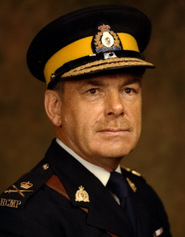
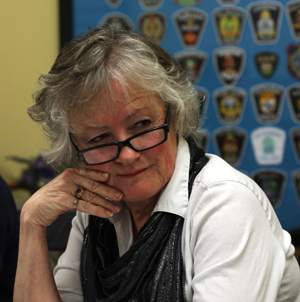
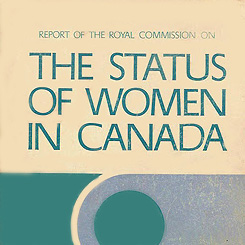
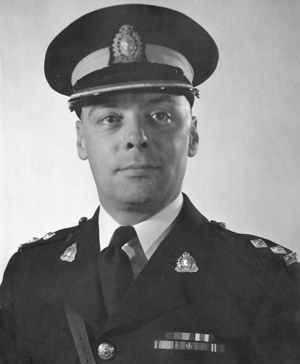

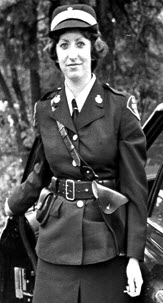

6 Responses to “A Tale Of Two Police Forces: 1974 A Milestone Year In Canada”